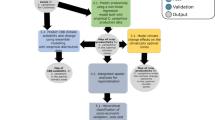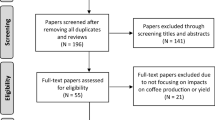Abstract
In this study we analyzed climate and crop yields data from Indian cardamom hills for the period 1978–2007 to investigate whether there were significant changes in weather elements, and if such changes have had significant impact on the production of spices and plantation crops. Spatial and temporal variations in air temperatures (maximum and minimum), rainfall and relative humidity are evident across stations. The mean air temperature increased significantly during the last 30 years; the greatest increase and the largest significant upward trend was observed in the daily temperature. The highest increase in minimum temperature was registered for June (0.37°C/18 years) at the Myladumpara station. December and January showed greater warming across the stations. Rainfall during the main monsoon months (June–September) showed a downward trend. Relative humidity showed increasing and decreasing trends, respectively, at the cardamom and tea growing tracts. The warming trend coupled with frequent wet and dry spells during the summer is likely to have a favorable effect on insect pests and disease causing organisms thereby pesticide consumption can go up both during excess rainfall and drought years. The incidence of many minor pest insects and disease pathogens has increased in the recent years of our study along with warming. Significant and slight increases in the yield of small cardamom (Elettaria cardamomum M.) and coffee (Coffea arabica), respectively, were noticed in the recent years.; however the improvement of yield in tea (Thea sinensis) and black pepper (Piper nigrum L.) has not been seen in our analysis.
Similar content being viewed by others
References
Basist A, Bell GD (1994) Statistical relationships between topography and precipitation patterns. J Clim 7:1305–1315
Changnon SA, Winstanley D (2000) Long-term variations in seasonal weather conditions important to corn production in Illinois. Clim Change 47:353–372
Chmielewski FM, Müller A, Bruns E (2004) Climate changes and trends in phenology of fruit trees and field crops in Germany, 1961–2000. J Agric For Meteorol 121:69–78
Cleveland WS, Devlin SJ (1988) Locally weighted regression: an approach to regression analysis by local fitting. J Amer Stat Assoc 83:596–610
DaMatta FM, Cochicho JD, Ramalho G (2006) Impacts of drought and temperature stress on coffee physiology and production: a review. Braz J Plant Physiol 18(1):55–81. doi:10.1590/S1677-04202006000100006
Das PK (1995) The monsoons. National Book Trust of India, India, p 88
Deutsch CA, Tewksbury JJ, Huey RB, Sheldon KS, Ghalambor CK, Haak CK, Martin PR (2008) Impacts of climate warming on terrestrial ectotherms across latitude. Proc Nat Acad Sci 105(18):6668–6672. doi:10.1073/pnas.0709472105
Easterling DR, Horton B, Jones PD, Peterson TC, Karl TR, Parker DE, Salinger MJ, Razuvayev R, Plummer N, Jamason P, Folland CK (1997) Maximum and minimum temperature trends for the globe. Science 277(5324):364–367. doi:10.1126/science.277.5324.364
Ewart F, Rounsevell MD, Reginster I, Metzger MJ, Leemans R (2005) Future scenarios of European agricultural land use I. Estimating changes in crop productivity. Agric Ecosyst Environ 107:101–116. doi:10.1016/j.agee.2004.12.003
Forster PMF, Solomon S (2003) Observations of a “weekend effect” in diurnal temperature range. Proc Natl Aca Sci 100(20):11225–11230. doi:10.1073/pnas.2034034100
Helsel DR, Hirsch RM (1992) Statistical methods in water resources. Elsevier, Amsterdam, p 522
Intergovernmental Panel on Climate Change (IPCC) (2001) Climate change 2001: the scientific basis. In: Houghton JT, Ding Y, Griggs DJ, Noguer M, van der Linden PJ, Dai X, Maskell K, Johnson CA (eds) Contribution of working group I to the third assessment report of the Intergovernmental panel on Climate Change. Cambridge University Press, Cambridge
Intergovernmental panel on Climate Change (IPCC) (2007) Climate change: impacts, adaptation and vulnerability, contribution of WG II to the third assessment report of the intergovernmental panel on climate change. Cambridge University Press, Cambridge
Joseph PV, Eischeid JK, Pyle RJ (1994) Interannual variability of the onset of the Indian monsoon and its association with atmospheric features, El Nino, and sea surface temperature anomalies. J Amer Meteor Soc 81–105
Krishnamurthy TN (1985) Summer monsoon experiment—a review. Mon Weather Rev 113:1590–1626
Lobell DB, Asner GP (2003) Climate and management contribution to recent trends in agricultural yields. Science 299:1032
Lobell DB, Field CB (2007) Global scale climate crop yield relationships and the impacts of recent warming. Environ Res Lett 2:014002. doi:10:1088/1748–9326/2/1/014002
Long SP, Ainsworth EA, Leakey ADB, Morgan PB (2005) Global food security. Treatment of major food crops with elevated carbon dioxide or ozone under large scale fully open air conditions suggests recent models may have overestimated future yields. Phil Trans R Soc B 360:2011–2020. doi:10.1098/rstb.2005.1749
McMichael AJ (2001) Impact of climatic and other environmental changes on food production and population health in the coming decades. Proc Nut Soc 60:195–201
Monteith JL (1981) Presidential address to the royal meteorological society. Q J R Meteorol Soc 107:749–774. doi:10.1256/smsqj.45401
Murugan M, Miniraj N, Carmelrani J (2000) Changes in climatic elements and their impact on production of cardamom (Elettaria cardamomum M.) in the cardamom hill reserves of Idukki district, Kerala. J Spices Aromatic Crops 9(2):157–160
Murugan M, Backiyarani S, Josephrajkumar A, Hiremath MB, Shetty PK (2007) Yield of small cardamom (Elettaria cardamomum M) variety PV1 as influenced by levels of nutrients and neem cake under rain fed condition in southern Western Ghats, India. Caspian J Environ Sci 5(2):19–25
Murugan M, Shetty PK, Raju R, Subbiah A (2009) The physiological ecology of cardamom (Elettaria cardamomum L) in cardamom agroforestry system. Intl J Environ Res 3(1):35–44
Parry ML, Rosenzweig C, Iglesias A, Livermore M, Fischer G (2004) Effects of climate change on global food production under SRES emission and socio-economic scenarios. Glob Environ Change 14:53–67
Peng S, Huang J, Sheehy JE, Lasa RC, Visperas RM, Zhong X, Centino GS, Cassman KG (2004) Rice yields decline with higher night temperature from global warming. Proc Natl Acad Sci 101(27):9971–9975
Pielke RA (2005) Consensus about climate change? Science 308:952–953
Porter JR, Semenov MA (2005) Crop responses to climate variation. Phil Trans R Soc B 360:2021–2035. doi:10.1098/rstb.2005.1752
Rosenzweig C, Iglisias A, Yang XB, Epstein, PR, Chivian C (2001) Climate change and extreme weather events—implications for food production, plant diseases, and pests. Glo Change Hum Health 2(2):90–104
Salinger MJ (2005) Climate variability and change: past, present and future—an overview. Clim Change 70:9–29
Sen PK (1968) Estimate of the regression co-efficient based on Kendall’s tau. Journal American Statistical Association 63:1373–1389
Stireman JO, Dyer LA, Janzen DH, Singer MS, Lill JT, Marquis RJ, Ricklefs RE, Gentry GL, Hallwachs W, Coley PD, Parone JA, Greeney HF, Connahs H, Barbsa P, Morais HC, Diniz IR (2005) Climatic unpredictability and parasitism of caterpillars: implications of global warming. Proc Natl Acad Sci 102(48):17384–17387. doi:10.1017/pnas.0508839102
Tao F, Xiong W, Xu Y, Lin Y (2000) Simulation of peanut potential yield under future climate scenario in China. Chin Environ Sci 20:392–395
Tao F, Yokozava M, Zhang Z, Hayashi Y, Grassl H, Fu C (2004) Climatological and agricultural production variability in China in association with east Asia monsoon and El Niño Southern Oscillation. Clim Res 28:23–30
Tao F, Yokozawa M, Xu Y, Hayashi Y, Zhang Z (2006) Climate changes and trends in phenology and yields of field crops in China, 1981–2000. J Agric For Meteorol 138:82–92
Thiel H (1950) A rank variant-method of linear and polynomial regression analysis, part III. In: Proceedings of Koninalijke Nederlanse Akademie van Weinenschapten A. vol. 53, pp 1397–1412
Thompson LM (1986) Climate change, weather variability, and corn production. Agron J 78:649–653
Thompson LM (1975) Weather variability, climatic change, and grain production Science 188:535–541
Whiteman D (2000) Mountain meteorology. Oxford University Press, UK
Yue S, Pilon PJ, Phinney B, Cavadias G (2002) Patterns of trend in Canadian streamflow. In: Proceedings of the 58th annual eastern snow conference. CGU, Ottawa, Ontario, Canada, May 14–17
Author information
Authors and Affiliations
Corresponding author
Rights and permissions
About this article
Cite this article
Murugan, M., Shetty, P.K., Ravi, R. et al. Climate change and crop yields in the Indian Cardamom Hills, 1978–2007 CE. Climatic Change 110, 737–753 (2012). https://doi.org/10.1007/s10584-011-0115-8
Received:
Accepted:
Published:
Issue Date:
DOI: https://doi.org/10.1007/s10584-011-0115-8




